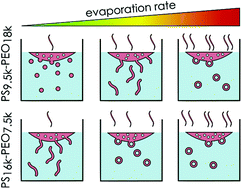Towards a rational morphology control of frozen copolymer aggregates†
Abstract
Kinetically frozen copolymer micelles are commonly prepared by confining amphiphilic block copolymers in the evaporating dispersed phase of oil-in-water emulsions. We revisit the mechanisms of this process by examining its successive steps separately: the formation of the solvent/water interface, the emulsification, the solvent evaporation and the formation of aggregates. We bring into evidence that: (i) spontaneous water-in-solvent emulsification, i.e., the formation of a double emulsion, is a necessary step for the subsequent assembly of the copolymers into kinetically frozen aggregates with certain morphologies far from equilibrium. (ii) Equilibration of the copolymer conformation at the solvent–water interfaces is a relatively slow process that can be outpaced, or even quenched before completion, by fast solvent evaporation rates. (iii) Rather than being dictated by the packing parameter at equilibrium, the morphology of the aggregates is determined by the effective copolymer conformation at the solvent–water interface when they form. (iv) Ultra-long worm-like micelles do not form by a direct digitation of the dispersed oil phase into the water continuous phase but through the inversion of the double emulsion. From these findings, we design a simple setup that allows us to control the morphology of the frozen aggregates obtained from a given copolymer composition by simply tuning the solvent evaporation rate.


 Please wait while we load your content...
Please wait while we load your content...